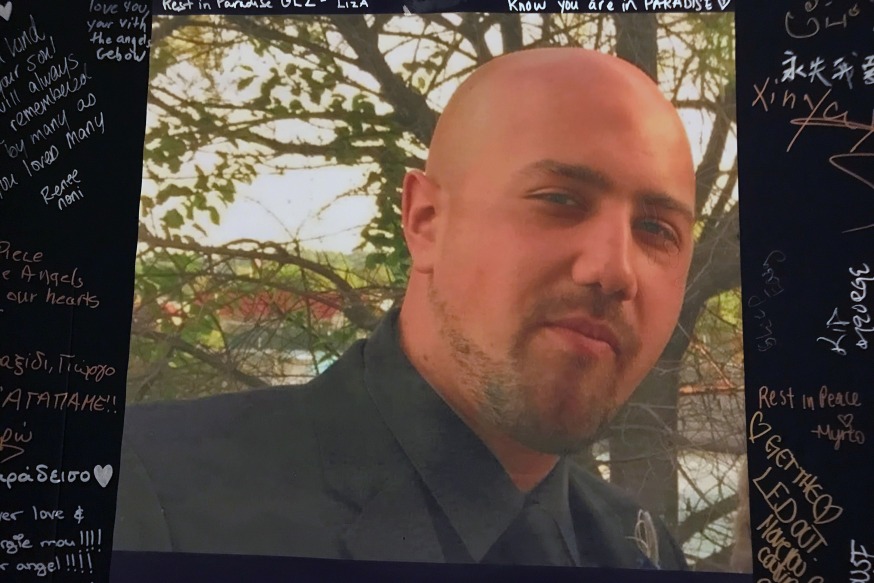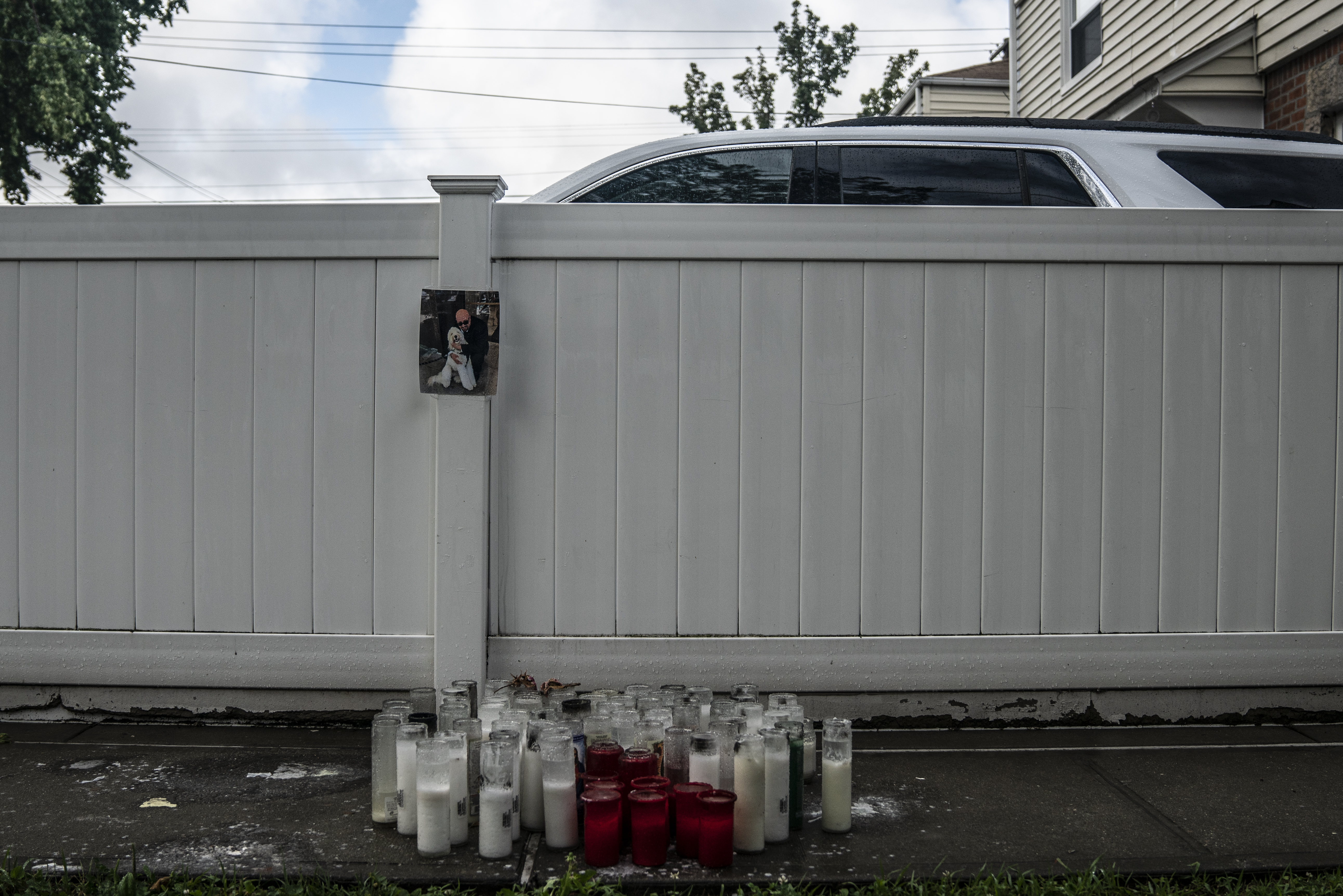
George Zapantis’ mother set up a memorial in her Whitestone, Queens home after her 29-year-old son died on June 21 after being tased multiple times by NYPD officers. | Yoav Gonen/THE CITY
 This article was originally published by The CITY on Feb. 4
This article was originally published by The CITY on Feb. 4
State Attorney General Letitia James has concluded NYPD officers were justified in using force on a Queens man with a history of mental illness after he moved toward them at the doorway of his home — including deploying Tasers seven times in less than four minutes.
The man, 29-year-old George Zapantis, died during the encounter with more than a half-dozen officers from the 109th Precinct in June 2020.
A report released Friday concludes a 19-month investigation by the attorney general’s office, which is responsible for investigating police killings of unarmed individuals. It found that because Zapantis had initiated the physical struggle, it would have been hard to prove officers weren’t justified in deploying Tasers to protect themselves and subdue him.
The AG’s office cited two state laws, one that governs the use of force for general self-defense, and the other that covers force by police officers in making arrests.

Attorney General Letitia James (Ben Fractenberg/THE CITY)
“It was only after Mr. Zapantis pushed his way out of his home, said he would hurt the officers, and began charging at them, that they used any force at all on Mr. Zapantis,” the report stated. “Once Mr. Zapantis charged at the officers, they were justified under [the law] in using force to defend themselves, including the use of restraint and the use of Tasers.”
Zapantis’ mom, Athanasia, told THE CITY she was “very, very upset” and “very, very disappointed” in the attorney general’s conclusions.
She said she drives to her son’s grave site every other day, and broke into tears when talking about his death.
“You killed my son in his house,” she said. “There were so many cops outside — they can’t hold him?” she added. “Did they have to kill him?”
Urged to Refrain
Police had been called to the two-family home in Whitestone that Zapantis shared with his mom and sister after a passerby saw him outside arguing with his upstairs neighbors. The caller mentioned a gun, but that turned out to be false.
The neighbors told police they had been arguing over a floodlight in their shared backyard — which Zapantis had insisted stay on. They said their son had seen Zapantis with a sword at his side, but that he didn’t threaten anyone with it.
The same neighbors told THE CITY shortly after the incident that they had urged the police to leave Zapantis alone until his mother came home because of his mental health struggles.
Instead, officers repeatedly knocked on the side door and called out to Zapantis to open it.
After several minutes, Zapantis pulled back a curtain covering glass panes in the top part of the door, revealing that he was dressed in a gladiator-like outfit — including a Spartan helmet and the sword by his side.
That’s when the police called for backup from emergency services units, who are trained to deal with so-called emotionally disturbed persons, or EDPs.
The attorney general’s report found that police officers tried to contain Zapantis inside his home at that point, including by unsuccessfully trying to tie the door shut with a rope.
But Zapantis soon opened the door again, this time without the outfit or sword, and began talking to officers through a screen door.
They asked him to turn around to demonstrate that he was unarmed, and he did, video of the exchange shows.
When an officer told Zapantis he shouldn’t have approached the neighbors with a sword by his side, Zapantis angrily responded by apparently pointing out the officer’s gun belt.
“Look at your waist, bro,” he said, before suddenly banging his arms through a screen door that separated them.
“I will fuck you up right now,” Zapantis said.
He Couldn’t Breathe
Amid a scrum of bodies, officers began firing their Tasers at Zapantis. They couldn’t get handcuffs on his wrists, even though his arms were behind his back at times during the confrontation.
They told him to get down on the ground, but he wouldn’t.
Zapantis screamed out in pain multiple times — including after being Tased — and at one point started shouting that he couldn’t breathe.
The officers told him he wasn’t being choked, according to the report, but one officer noticed Zapantis’ shirt was possibly constricting his neck.
“The shirt, the shirt, the shirt” the officer said.
Someone cut it with a seatbelt cutter, the report found.

The memorial Athanasia Zapantis created for her son, George, at their Queens home. (Hiram Alejandro Durán/THE CITY)
Toward the end of the encounter, Zapantis’ screams turned into squeals and then silence, the body-worn camera footage shows.
“He’s breathing, right?” one of the officers asked.
George Vomvolakis, an attorney for the Zapantis family, didn’t return calls for comment on Friday.
He previously told THE CITY, “It doesn’t take a trained professional to realize that six people on top of somebody and Tasering them repeatedly could potentially kill them.”
Ruled a Homicide
In late 2020, the city’s office of the medical examiner ruled Zapantis’ death a homicide.
It was attributed to “cardiac arrest due to dilated cardiomyopathy of undetermined etiology during physical restraint by police — including conducted electrical weapon use.”
Officials in the office explained that Zapantis had a disease of the heart muscle before the interaction with police, but that it was the encounter, including the use of Tasers by officers, that led to his death.
Within days of the incident, NYPD officials claimed that cops tased Zapantis after he “began to engage the officers and approach them with sword in hand.”
But the body-worn camera footage doesn’t show that.
The attorney general’s investigation concluded that the frequency of the use of Tasers against Zapantis was reasonable based on prior court rulings.
He was struck three times with Taser darts — which emit an electric shock — and once with a pain-inducing drive-stun Taser, over a 3-minute period. Three additional Taser deployments didn’t function properly, the report found.
“Courts have determined that multiple Taser applications may be reasonable when necessary to subdue a subject,” the report says.
Police Still Main Responders
Zapantis’ death was one of many that raised questions about the city’s response to mental health crises. At least 16 people with psychiatric challenges have died at the hands of police in New York City since 2015, a trend that has spurred calls to send mental health professionals instead of police to those incidents.
The administration of former Mayor Bill de Blasio for years promised to implement such a program, but a test-run was repeatedly delayed — including because of the coronavirus pandemic.
A pilot program was finally launched in June 2021 in parts of Harlem, with emergency service technicians and social workers designated as the first responders to mental health crises that aren’t deemed to be dangerous.
It got off to a bumpy start, with police still handling 80% of the mental health emergency calls, THE CITY previously reported.
More recent data shows that over the first six months of the program, 911 mental health calls were only routed 22% of the time (684 calls) to the teams of social workers and EMTs.
The rest were handled by police.
THE CITY is an independent, nonprofit news outlet dedicated to hard-hitting reporting that serves the people of New York.






